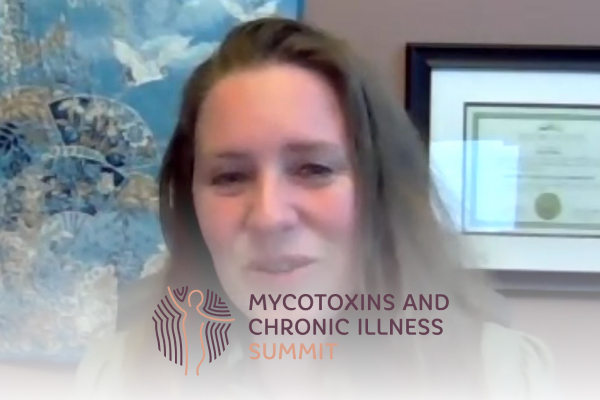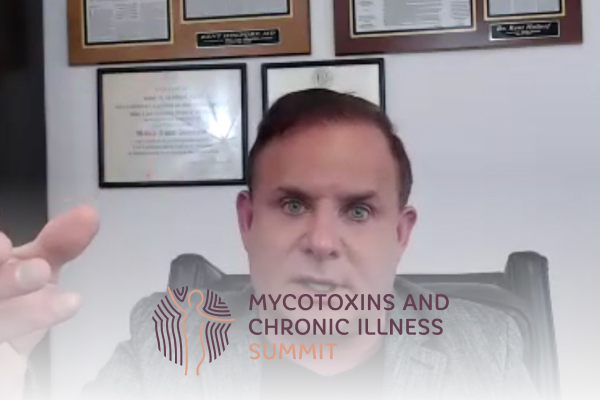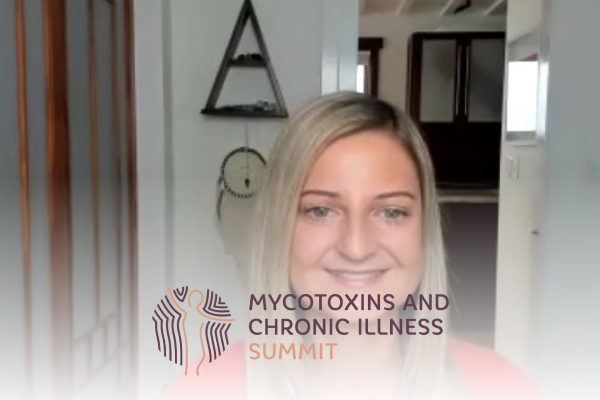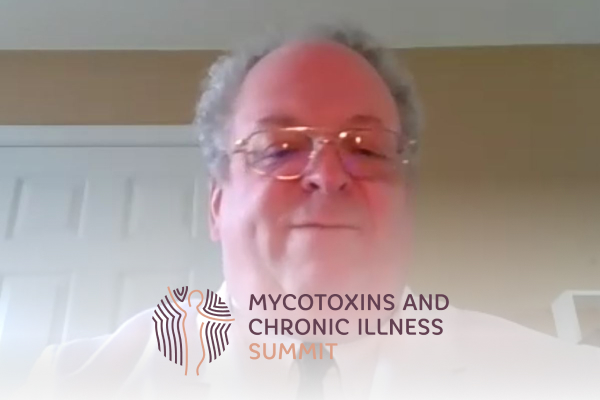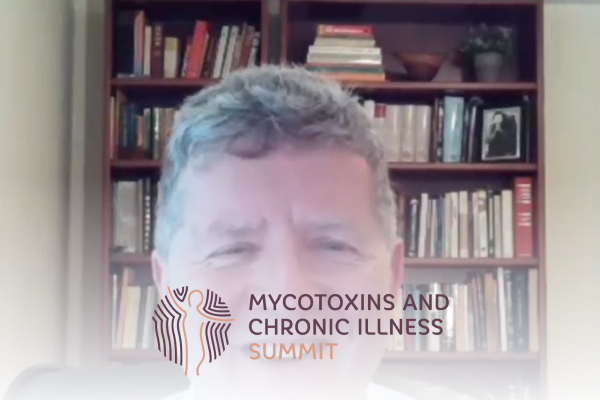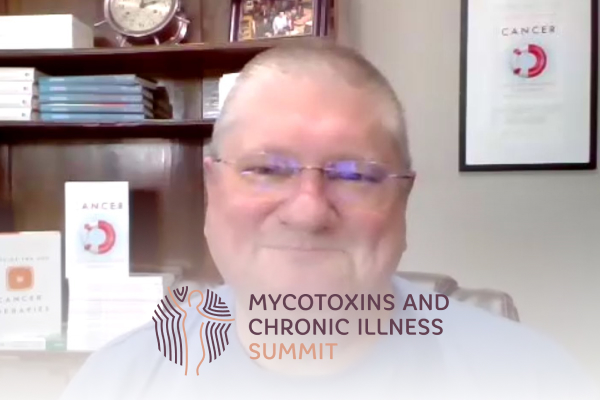Join the discussion below

Nafysa Parpia, ND has an independent practice at Gordon Medical associates, specializing in the treatment of Lyme disease and other complex chronic illnesses such as autoimmunity, mold toxicity, fibromyalgia, environmental toxicity and gastrointestinal disorders. Her patients with chronic Lyme Disease are typically those who either do not do well with antibiotics, or prefer... Read More
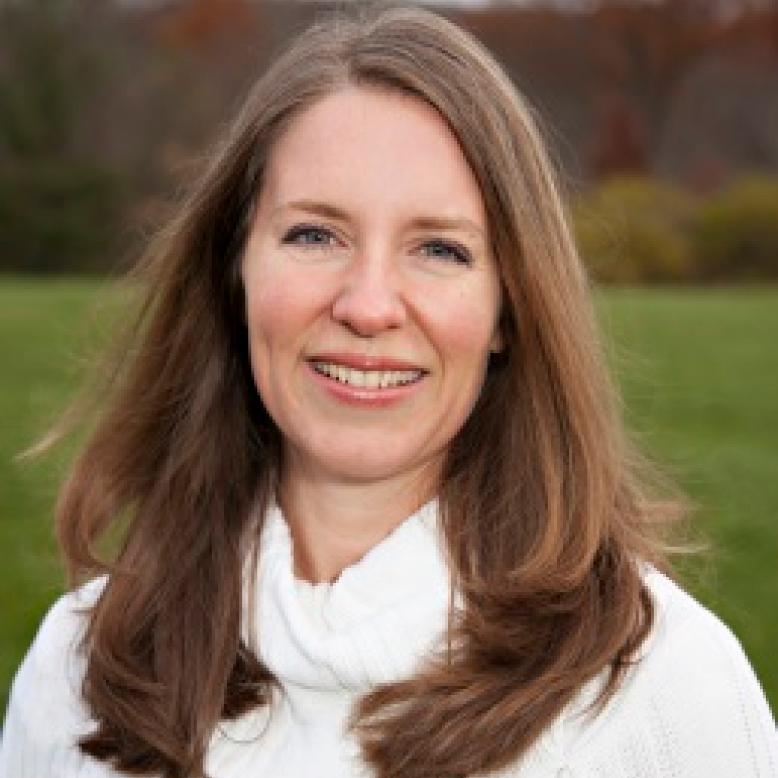
Beth O’Hara is a Functional Naturopath, specializing in complex, chronic cases of Mast Cell Activation Syndrome, Histamine Intolerance, and Mold Toxicity. She is the founder and owner of Mast Cell 360, a Functional Naturopathy Practice designed to look at all factors surrounding health conditions – genetic, epigenetic, biochemical, physiological, environmental,... Read More
- Beth O’hara’s Journey
- Mass cell
- Mass cell activation syndrome
Nafysa Parpia, N.D.
Welcome to today’s episode of the Mycotoxin and Chronic Illness summit. I’m so happy today to have Beth O’Hara with us. She’s a functional naturopath specializing in complex chronic cases of mast cell activation syndrome, histamine intolerance, and mold toxicity. She’s the founder and owner of Mast Cell 360, a functional naturopathy practice designed to look at all factors surrounding health conditions, genetic, epigenetic, biochemical, physiologic, environmental and emotional. She designed Mast Cell 360, to be the kind of practice she wished had existed when she was severely ill with mast cell activation syndrome, histamine intolerance, mold toxicity, neural inflammation, Lyme, fibromyalgia, and chronic fatigue. Her mission today is to be a guiding light for others with mast cell activation syndrome, histamine intolerance, and these related conditions in their healing journeys. Thank you, Beth.
Beth O’ Hara, FN
Oh, thank you. I’m so happy to be here. And I know this whole summit is a game changer for people, and I think some of the things we’re going to get into will start to shift how people are healing and help them heal faster and hopefully with less money than what it took me to get well, and probably many people you know as well.
Nafysa Parpia, N.D.
Yeah. So I’m so happy to have you here. So start by telling us about what you’ve experienced. I’d love to hear and have you share about your journey with all of this.
Beth O’ Hara, FN
Yeah, I think that’s a big part of what, what I do now, where it stems from. When I was seven, we moved to the country, which was fun in a lot of ways, but we moved to this old farm house and did not know it was full of toxic mold. I didn’t actually know that until I was in my later twenties, but I started having these health issues creep up early on. So by the time I was 12, I was having hypoglycemia and having things like my vision start to black out, and I had these severe allergies. I would have hives all over. And when you grew up in the country, you’re always picking and canning green beans. And one of my jobs was also to feed the chickens. I’d have to feed them corn, dried corn, and then I’d just be covered in these hives.
And I would scratch my skin at night and until I bled and, you know, scratching my eyes and always these itchy, allergy kind of symptoms. And then around age 12, like I started getting asthma, I was getting, I was tired. I was always more tired than other kids and I had a car accident. I was 16. I just couldn’t bounce back and get out of bed. But I was still moving along. And it was my just absolute passion to go to medical school. So I decided this by the time I was six, and just to illustrate how serious I was when I was 16, all I wanted was Grey’s Anatomy. It was like, if I got a copy of Grey’s Anatomy, I was good, didn’t need a car. And I was, you know, finding bleached skeletons in the woods and reassembling them. And just so you can get a sense of how important that was to me. And so I was pushing way too hard in college.
I was working three jobs and I was taking graduate level courses as an undergrad. And I was working with a PhD student on research and the summer of my junior year, I just totally crashed out. And I was so severely fatigued that I knew if I made it through the four years of medical school, I would never make it through residency. So one of the most devastating things in my life was turning down, I had a full scholarship and I had to turn it down and figure out what in the world else was I going to do. And instead of going to medical school, I had to become a chronically ill patient, going the circuit, you know, from doctor to doctor to doctor. I’d completely exhausted what Western medicine had to offer.
And it was actually making me worse. Every medication made me worse. I remember there was, I had such severe anxiety and depression at this point, and I had tried different kinds of antidepressants. And someone had me try Depakote. I had a sixth of a tablet and my body temperature dropped to 94. My organs felt like they’d slowed down. I didn’t have a bowel movement for a week. So that was like a sixth of a tablet, right? So starting to get these weird reactions that nobody understood. And then I discovered holistic medicine, I tried everybody that I could get my hands on, that wasn’t working. I did homeopathy, functional medicine was growing. And I found the most skilled and experienced person in my area, ’cause this was all before tele-health, you know, now you can get in contact with all these experts and professionals around the world, but back then it had to be in driving distance or you had to be able to fly.
And I was too sick to travel very much. And so the most experienced person in my area, I tried everything, everything he recommended for three years. And it was down to where it’d be like a quarter of claritin, I mean, a sprinkle of claritin was giving me worse anxiety. And I couldn’t sleep that night. And curcumin was making me more inflamed. So everything was paradoxical. And by the time I was 28, I had to use a cane to just barely hobble across the room. I remember holding my bladder cause it was so excruciating to be able to get up to go the bathroom. And my friends were out dancing and I was wearing orthopedic shoes in just this horrific pain that kept me from sleeping and my sleep was terrible.
So about three years into working with a functional medicine practitioner, which I think was about practitioner 50, number 50, who I tried, he said, “You know what, Beth, we’ve done everything I know what to do. We’ve reached the end of where I know to go with you.” And I really appreciated his honesty, but I thought, oh my gosh, you know, this is practitioner number 50. And if he doesn’t know what to do, and I had spent $150,000 at that point, who’s going to know this? And I cried the whole drive home and it was exhausting just to get there and get back. And I got home and I thought, you know, I can either throw in the towel and be done with my life at this point, or I can figure this out. And I at least had that pre-med background. So I started reading, studying everything I could get my hands on.
We knew I had Lyme, but I couldn’t tolerate any treatments. We knew I had bartonella barbesia. I knew I had histamine intolerance, but I finally found about mast cell activation syndrome. And this was like eight, nine years ago. Soit was still kind of this theoretical thing. It wasn’t an official diagnosis yet. And a lot of people didn’t know about it, but I was like, oh my gosh, this makes sense. And then I thought, well, that’s the answer. And I started addressing it, but I still couldn’t tolerate taking much. I started with tiny sprinkles in water and then like a sip of water. And then I wouldn’t drink the rest of the water.
But over a couple years I got some things on board. I got a little better, but I still was really struggling and then realized, well, wait a minute, why are these mast cells stirred up? Why am I so inflamed? What is happening here? It’s not just that it’s mast cell activation syndrome. There’s something triggering that. And I realized there was something beyond the Lyme as well. And that’s when I figured out the mold toxicity. And when I realized I had the mold toxicity, everything made sense. Cause I didn’t know that toxic mold from years ago could make you sick and could stay in your body and colonize and then just continue to produce toxins. Plus I was renting a office space in a historic building that was built after the Civil War.
And so I was on the lower level. Well, when I went to move out of there, the plaster just crumbled when I took stuff off the walls from it just being wet and figuring that mold toxicity piece and starting to address that in ways of working with my nervous system, calming those mast cells and then detoxing, that was the game changer, it was like I got my brain back. My anxiety, this anxiety I’d had for 20 years, it was horrific, it was gone. I almost never have anxiety anymore. I got my joints back. I just did a mile hike, or an hour long hike, actually. I don’t know how long it was, but a couple of days ago, when I could barely walk across the room. So for me just every day feels like a gift and a blessing. And I got my brain back to go back to graduate school and I finished two graduate degrees and I built this practice and stuff that I just never thought was going to be possible. I thought my life was going to be on the couch and that was the best I could do. And I just, I feel so grateful now.
Nafysa Parpia, N.D.
Thank you for sharing that with us. You know, you sound exactly like most of my patients and your patients as well. And having people hear your story, I think gives them a lot of hope. There is hope, and when people first walk into my office, they don’t believe that they can heal. They have seen 50 other doctors before coming to our clinic and we’re lookingunder the hood. We’re looking at things that in medical school we’re not taught to look at, whether it’s allopathic medical school or through functional medicine or even naturopathic school, we’re taught how to be primary care physicians, excellent primary care physicians, but looking at chronic illness is absolutely a different theory, a different lens and a different application of medicine. And so you sound like somebody who’s been through everything, it sounds like you had mold, tick-borne illness and then secondary to all of that, mast cell activation syndrome and maybe even other environmental toxicants, I’d love to hear about your journey back to health. Can you share with us?
Beth O’ Hara, FN
Yeah, I’d love to, and there’s so many layers. I mean, I’ve had severe chronic SIBO. I’ve had Epstein-Barr, I’ve had HSV viruses attacking my nervous system. I mean, it’s just so many things that people go round and round and round about I dealt with, I started, like I said, well, there were a couple of things. One of the things that was a big shift and probably one of the reasons that I’m still here was when I was in college, I discovered yoga and I know yoga now, like there’s a yoga studio on every corner and you go to the YMCA, but this was more than 20 years ago. And when I was in college, I had to have two PE credits. And most of the stuff was, you know, you could play, you could take volleyball, you can take basketball or you can do swimming. I couldn’t do any of that stuff. I was having trouble walking two or three blocks. So that was not going to happen. And I wasn’t quite, I have EDS, I don’t have coordination. And then I had a head injury when I was a child and I have a little cerebellum damage, so I don’t have good coordination. So I couldn’t play billiards like that was off the table. And the one thing I thought it could do is yoga. And I was so fortunate that the teacher was like a very genuine Iyengar yoga teacher. And so this was a classic medical, therapeutic style of yoga.
Nafysa Parpia, N.D.
I love to hear that because there’s a lot of McDonald’s yoga out there.
Beth O’ Hara, FN
There is.
Nafysa Parpia, N.D.
And it’s so hard to find what is authentic anymore in the world. Back then we could.
Beth O’ Hara, FN
Yeah, and so that was a game changer for me because I was in so much intense pain and I had pain from these injuries, this head injury and the car accident and things that hadn’t been addressed. And so my main strategy was to get out of my body.
Nafysa Parpia, N.D.
Right.
Beth O’ Hara, FN
So yoga made me start to become into my body and be present and be aware. And I was so used to school coming easy and I’d never had anything that was really challenging. And that was the hardest thing I had ever done in my life was to be in my body for an hour and a half. And so, and it wasn’t what I thought. I thought it was going to be chanting ohm and then taking a nap.
Nafysa Parpia, N.D.
Right.
Beth O’ Hara, FN
But it started to get me to move and it started to shift things and it made me more aware and more attentive to what was happening in my body, it was very uncomfortable and unpleasant, but it was a massive tool for me later in life in terms of healing and being able to track what was happening and watch what was happening and know is this good for me? Is this not good for me? Because there was no map or no formula for getting well. And I ended up getting trained in that style and becoming a medical yoga therapist. So that was one of the things I did when I couldn’t go to medical school.
I was an unusual one because a lot of times I had to teach from a chair because I was too ill to demonstrate, but that’s what I did for awhile. And I started, like I said, with these little sips of sprinkles is what I call it. Put a little sprinkle of something in water, stir it, take a sip and that’s enough, right? The other piece for me was that intense nervous system work. But again, this was before we had DNRS and goop to program and brain tap and all these amazing really targeted systems now that work so much more effectively. So it was a lot of experimentation and seeing, does this breathing practice calm my nervous system or does it excite my nervous system and honing in and then finding, well, that changes week to week and month to month, but experimenting there and really dialing that down. I also did a huge amount of emotional healing and there’s a big trauma that comes with being this ill as I know you know, very well and it’s so hard. And then also I wish this was unique, but it’s very common.
So many practitioners when they didn’t know what to do with me or my case scared them, told me that I was crazy, or they told me that I wanted to be sick. That was the worst. I could take being told I was crazy. ‘Cause you know, sometimes I wondered with the anxiety, but being told that I wanted to be sick when I was working so hard was one of the most horrible things to hear. And I did a lot of emotional healing work with a system, particularly a system called the Enneagram. And it’s about watching our patterns and knowing our motivations. And those two pieces really kept me going in the darkest days of knowing that, okay, well, my pattern is to not ask for help and to think that my needs aren’t important and to not take care of myself. And so I had to really overcome that aspect of it while I’m doing these sips of sprinkles.
So it took me about two years to build up to a quarter capsule of anything. And at that time, I didn’t know that what I was working on adding in were mast cell stabilizers, but I was trying to get Claritin on board. I was trying to do things like boswellia. So I started there and I started with all this nutrient tinkering. And then I got into genetics and did a lot of genetic tinkering, which did get me some inroads. And I had a lot of variants on glutamate and a lot of variants and some of these other pathways that we were looking at the time, methylation pathways and so on. And so I could get little bits of things that would calm the glutamate and that would help the anxiety.
But I didn’t know at the time, I didn’t understand how much mold toxins, didn’t even know about them yet, increase those glutamate pathways and change that genetic expression and how Lyme changes that genetic expression. But that was kind of that crawl out, then I figured out oxalate issues, that I had massive oxalate issues and that was affecting my joints. So I shifted my foods. I was eating tons of sweet potatoes and spinach and beets, all those super high oxalate foods, that got me off the cane. And it was like stepping stone by stepping stone because I didn’t have this paradigm or this foundation that we understand today. I was shooting in the dark and finding one little piece, one little piece, one little piece,
Nafysa Parpia, N.D.
You’re doing this on your own, as well?
Beth O’ Hara, FN
Yeah, it was mostly done on my own, occasionally, I’d find a practitioner who would have a Pearl and I could incorporate the Pearl, but I hadn’t found anyone who really got my case. And I didn’t until I met Neil Nathan, who’s my mentor now. But then he put the last of the pieces together. I was like, whoa, we were off to the races at that point.
Nafysa Parpia, N.D.
Beth, how many years ago was this?
Beth O’ Hara, FN
Well, this journey, I mean, I really started at 19 on my own figuring out what was going on and going from doctor to doctor on my own. But even as a child, I was on lots of antihistamines and mast cell medications and they helped me. But then I think they made it worse long-term ’cause it’s all I had. So I wiped out my defenses and I would say, you know, I really probably started turning the corner about four or five years ago.
Nafysa Parpia, N.D.
So this recent, your healing.
Beth O’ Hara, FN
It’s kind of recent. It wasn’t like a sudden. I mean, I went back to graduate school. I got a master’s in marriage and family therapy. And then I went back and finished in naturopathy. So I got some energy and brain power back to start to do those things, but to be alive and vibrant, I would say has been, you know, more recent.
Nafysa Parpia, N.D.
Good for you.
Beth O’ Hara, FN
Thank you. And again, every day I’m so grateful.
Nafysa Parpia, N.D.
This is quite a journey you’ve been through and more and more, there are people who share your story and I’m so grateful you’re out here talking about your story because people do, they feel isolated, they’re told they’re crazy, or they’ve been told that they want to be sick and none of these things are true. And to have you who’s been through it and now you’re here. You’ve turned it into something. You’ve turned it into a gift to share back with the world. So it’s just such a beautiful thing you’ve done with what you’ve experienced. And I know there are a lot of my patients out there who, you know, who know they will do something as well to make beauty out of what they’ve experienced.
Beth O’ Hara, FN
That’s our mission here at Mast Cell 360. I mean, it’s written right into our mission that we’re not just here to help people recover their health. We’re here to help people recover their lives and their dreams, that’s what you all do it at Gordon Medical as well. And that’s one of the very optimistic things is, you know, I tell my injuries like, oh my gosh, who wants to go through all that, but we don’t have to anymore because this is, I think we’re in this Renaissance of understanding mold toxicity. And there are lot of practitioners who are really skilled in this area and you can get help. And so people don’t have to navigate this on their own.
They don’t have to figure it out on their own and they don’t have to take 20 years. And at one point I had totaled up, eventually I’d seen over 75 practitioners. And I think I’ve spent over $300,000 figuring this out. I mean, all my resources went to it, to get well, because if I didn’t have my health, I mean, I couldn’t work. What was the point? And now we don’t have to do that. People can get well, a lot of times I see people who are really ill and they’re done in two to four years, if it’s really complex, it’s maybe five years, which still sounds like a long time, but it’s so much shorter than 20.
Nafysa Parpia, N.D.
Yes, or a year.
Beth O’ Hara, FN
They’re spending fractions of what we had to spend when we had no idea what was going on.
Nafysa Parpia, N.D.
Absolutely, so we both work a lot with patients who have mast cell activation syndrome. How about you tell our viewers a little bit more about what that is and how to handle it?
Beth O’ Hara, FN
Yeah, so one of the really fascinating things about these mast cells is that they are these frontline defending and sensing cells of our bodies. And they’re in all of the tissues that meet the outside. So our skin and our nose and our sinuses and our eyes, all that tissue and the whole GI tract from the mouth down the esophagus and in all the way through the intestines and they’re in the lungs and then the muscles and the bones and they’re in almost every tissue in the body. Other than I believe it’s the cornea. There might be a couple others, but they’re pretty much everywhere. And one of other things that’s fascinating is they’re at every nerve ending.
So there’s this constant communication between these mast cells and our nerves and the nervous system, because the nerves are sensing and that’s how this detecting viruses and bacteria and toxins, and also looking for injury and where repair needs to happen, all these things. So they have these huge amount of functions in the body that we don’t even have time to get into all of them. How are they involved in pregnancy and how are they involved in sleep-wake cycles? And then the way they do that is they have hundreds of receptors on the outside that detect all these different things. So we’re still learning things about them, which I love too, new receptors and how these receptors work. And they were first discovered in the 1800s, the later 1800s.
So I love it when there’s something you can always keep digging into layers on and learning about. And then they have these hundreds of different mediators inside them. They can release depending on what’s going on and communicate and orchestrate some of the immune response. One of the big orchestrators of how our immune system works. So they’re so important. And I want to highlight the benefits of them because they tend to get a bad rap, right? Like we should just shut those mast cells down.
Well, the problem is if they’re like the guards of the castle gate, you don’t want to wipe your guards of your castle gate out because then you don’t have anybody defending. And I think that’s part of why I got so sick and that’s all people knew to do with me when I had this horrible hives and itching my skin off was to give me mast cell stabilizers and antihistamine. So it made sense, but then I didn’t have any defense system against the mold colonization. I didn’t have any defense system against the lime, the Bartonella Babesia and the Epstein-Barr, all these other things.
So this big chronic toxin or pathogen load buildup and toxin load, but then what happens? The metaphor I really like is if you have these guards of the castle gate, they should be able to be on duty and take a break and be on duty and take a break. Except we live in this massively toxic world now. And we’re completely bombarded by different toxins. We have stress levels we’ve never had in human history, responsibilities we never had, access to media we’ve never had and seeing all kinds of terrible things. And also sensationalism is stressful and we’ve got EMF levels we’ve never had in human history and mast cells, there’s clear, clear data in the research literature that mast cells degranulate in the presence of EMFs. So they release all those inflammatory mediators.
So it’s like they have to be on duty 24/7. And we know that if we don’t get to rest and we’re on duty for, you know, seven days, 10 days, 28 days in a row, you’re going to get pretty wonky, can’t think straight. And so on a biochemical level, the mast cells start to lose the ability to discern, oh, that is something that we need to keep out. That’s an enemy and, oh, that’s a grain of rice or some broccoli or carrot. It should be fine. So it’s like they start shooting at the butterflies when they can’t tell the difference anymore between friend and foe. And then they get hyper responsive. So I like to think of them like they’ve got PTSD, so they’re kind of trigger happy and hypervigilant. And it’s part of that immune system, nervous system, that psycho neuro immunological axis going on there.
Nafysa Parpia, N.D.
Right, I think of it as our patients have a combination of, on one hand, a hyperactive immune system with mast cell activation syndrome and autoimmune conditions. On the other hand, their immune system isn’t strong enough to mount an appropriate immune response to deal with the infections that they have. And so finding ways to modulate the immune response where it’s not hyperactive but also not so weak that it cannot kill an infection appropriately. What you say about toxins I think is so important because we’ve had these bugs.
When I say bugs, I’m thinking of molds and parasites, bacteria, viruses, we’ve had them around us since humankind has begun. And we’ve been able to live side by side with them until, recently, I’d say in the past 20 years, we’ve been seeing people more and more who’ve experienced what you experienced. And I think it has everything to do with the environmental toxicant load because that’s something that our genes will. It takes 25,000 years or more for our genes to change, but they’re expressing epigenetically now in a way that they weren’t before I think due to the environmental toxins and a new kind of stress that everyday people are having.
Beth O’ Hara, FN
Exactly, and when you think about around 2004, 2009, that period was when we started bringing wifi routers in our homes. And so all these things interact and they make the mold more virulent, it’s producing more toxins, they’re producing stronger toxins. And that’s all adding load, especially when we’re talking about this immune balance, where that TH1 virus and bacterial killing side gets really dampened and I have a slide I use in the mold course that I teach for sensitive people on how we have the Seesaw kind of thing that should be balanced with this pathogen killing TH1 side. And then that TH2, that includes the mast cell side, should be kind of in balance, but then mold is like this huge weight that just boom, it takes the TH1 side out and then we’re left with this elevated mast cell activation, chronic expansion. So we’re inflamed and we can’t kill anything off.
Nafysa Parpia, N.D.
Exactly.
Beth O’ Hara, FN
Yeah, mold just, and it disrupts so many systems in the body.
Nafysa Parpia, N.D.
Yeah, it sure does. Will you tell us about the research that you did with Dr. Nathan and some other doctors as well around binders, it’s very interesting.
Beth O’ Hara, FN
I would love to. And so this research was done with Dr. Neil Nathan, Emily Gibbler, who’s a colleague of mine at Tree of Life Health and Dr. Joe Mather, and how this kind of came about was that, Emily and I are on the board with Bob Miller for the Nutrigenetic Research Institute. So we were preparing for conference on mold toxicity and genetics, and she and I took different pathways and mapped out the phase two liver detox pathways and mapped out which mold toxins were detoxed by these different pathways. And so this is where it started. This was such a game changer because I was using glutathione and I know a lot of people were using glutathione for mold detox. And what we found was aflatoxin B one and ochratoxin use glutathione. We couldn’t find any data on glutathione in any of the other mold toxins being conjugated with glutathione. But the biggest pathway was glucuronidation, which I, when I went in, so I volunteered to cover glucuronidation thinking this won’t take much because in my textbooks, we had two pages covering it, and that was it. So it should be pretty simple pathway. It took me six months.
Nafysa Parpia, N.D.
Wow.
Beth O’ Hara, FN
To get through the research data, just on it and the mold toxins and wrap my head around the depth of this pathway that we’re not talking about enough and how glucuronidation path is the most important of the phase two pathways. And it breaks down up to 70% of all chemicals and medications. It breaks down our hormones, our fat-soluble vitamins, like A, K, E, D, things like CBD. And then a lot of people get salicylate intolerance, mold toxicity, well, glucuronidation is one of the pathways. So you think about being the major pathway for mold toxins, and it’s a complex pathway. Well, you load that down. You use up all the enzymes for those mold toxins. There’s not anything left for salicylate. That’s part of that. And then sulfation is involved and that’s part of the salicylates. So that’s kind of how it started.
Neil Nathan was at a conference and he came up to us afterwards. He was like, look, we got to get this consolidated. We gotta get this out there. So he got us organized and going, and then I got to meet Joe Matther and Joe Matther did a bulk of research on binders. And I got to tag on to that a little bit. And what we found with the binders and I want to really give credit to Dr. Matther. What we found with the binders is that, you know, a lot of us were using like charcoal, cholestyramine, for binding mold toxins. And those will bind some, but cholestyramine really works for ochratoxin. I haven’t had great success with it with sensitive people. Either it’s pretty intense for people usually, but we’re missing so many other mold toxins that they’re not touching. So gliotoxin, gliotoxin doesn’t have an affinity for Cholestyramine, at least that we’ve found any data for.
So where we’re starting to do this precision detox approach, where now we have a matrix and we’re continually updating it as new research comes in, but we can look at, okay, we’ve got ochratoxin. So these are the preferred binders that have the best affinity or we’ve got the aphrotoxin or the gliotoxin. So let’s bring these in or this person is now excreting more gliotoxin. So we want to bump these up a little bit and we’re finding people are actually having an easier time and they’re getting done faster with this targeted approach. And once they get those binders on board, then we can go to phase two pathway. And I’d love to look at the genetics and go, oh gosh, there’s a lot of genetic variance in glucuronidation. Let’s support there. And somebody might want to do a little support there lifelong if they’ve got a lot of variants in these certain places.
Nafysa Parpia, N.D.
Thank you. I love that. I love that it can be so specific now, thanks to the research that you’ve all done, because we, in this kind of medicine, there’s not enough research and it’s been a lot By clinical trial and error. And so the more and more research we have, the easier our job is to help the patient to heal faster. The easier it is on the patient, that’s the most important thing. And also we’re now able to teach other other doctors about, about this hidden information. You’re bringing it to the surface. So I just love it. I love that.
Beth O’ Hara, FN
Yeah, I do too. And especially that order as well, I see a lot of people come in where it’s just not understood widespread enough that we need to open up these pathways in a really logical order, by making sure constipation’s addressed and then calming the mast cells so that they can handle the load of pulling the toxins out of the tissue, calming the nervous system. Then we can do the binders and, and then support the liver and then support, and then bring in those antimicrobials. But there’s a lot of times I have people come in and they’re trying antifungals, and they still have constipation, or they don’t have any binders on board yet. And that’s really backfiring for people really.
Nafysa Parpia, N.D.
It really is, or people are on binders and they’re constipated. They’re just not ready for detox. I like to give my patients a pre-tox even, which is just support the organs of elimination, treat their mast cells first, work on the nervous system. A lot of patients have cranial, cervical instability, varying degrees of it, and to work on that even before treating with mast cell modulators, and then detox finally started, kill off infections while I’ve got all the other stuff on board. It sounds like we really take the same steps forward in treating patients. I’ve had a lot of people come into the clinic and they’ve been on antibiotics for years, and none of the others stuff has been addressed. And they just keep going with the antibiotics, even though it’s not working, they say that they feel like zombies, or they feel like shells of themselves with this way of treatment, but then they keep pressing on because what else are they to do? But you and I have the same message, it’s clear that there’s so much more to do before and during the time of killing off the infections. And so there’s so much that we have to undo in these patients that come to us this way, support them in every system.
Beth O’ Hara, FN
Absolutely. I have another, I love visuals. And so I have another visual I like to use where I have this house that’s under construction, so you can see that the foundation’s been poured. And then all of the wood framing is up, right. But that’s it, there’s no real walls or anything. And then I have on there, these windows with shutters and I have Lyme and I have SIBO and then the mast cell activation. And if we have mold toxicity and we think that we’re going to get rid of this stuff, that’s upstream of it. It’s like trying to put the shutters and the windows on the house where you don’t even have the walls built out yet. And it might hold up for a day or two, but then the mold toxins are just this wrecking ball.
So this wrecking ball that just comes through and knocks the windows down, and that’s the mold again. And it’s order of operations. I love you’re talking about the cervical cranial instability as well. Because that was a big part of why I was so ill, was the head injury and I was kicked in the head by a horse. And so I had a Chiari malformation and cerebral spinal fluid buildup. I have gotten craniosacral therapy for years. We actually just found that Chiari malformation for me this year. And so that, you know, there’s all these pieces that we’ve gotta be thinking such big picture, and then thinking also what’s happening spiritually and emotionally and instructionally, so I can’t tell you how excited I get when I get to talk to someone like you about, you know, people are taking this big picture look because it literally changes the face of not just healthcare, but people’s lives.
Nafysa Parpia, N.D.
It sure does. Thank you so much, Beth. I just so enjoyed our interview and just bouncing our ideas between each other and seeing them mirrored. We don’t see that happening so often. So it’s just such a treasure to meet you and have this interview.
Beth O’ Hara, FN
Thank you so much. It’s wonderful to talk about. And I just want to share that we have tons of free resources, people need help. And I know that you guys have an incredible clinic and we’ve got a blog and we’ve got courses where people can instruct themselves through how to work on the nervous system and start the mast cell supplements and the mold detox. And thank you so much for getting this information out there. If I had had this even 10 years ago, it would have changed my life. And I know it’s going to change a lot of people’s lives.
Nafysa Parpia, N.D.
It will, Beth, tell them what your website is. I love your website. It’s full of information and fantastic information. So tell them the website.
Beth O’ Hara, FN
So thank you so much. It’s Mast Cell 360. So M as in Mary, A-S-T as in Tom C-E-L-L 360 dot com. And then we also have free Facebook lives, most Mondays, and people can jump on there and ask questions too. So we try to provide a lot of community support. Because again, I don’t want people to have to go through this alone, like I have.
Nafysa Parpia, N.D.
Thank you again. Thank you for everything you’re doing.
Beth O’ Hara, FN
Thank you enough, Nafysa. It’s so good to be with you.
Nafysa Parpia, N.D.
You too.
Downloads

